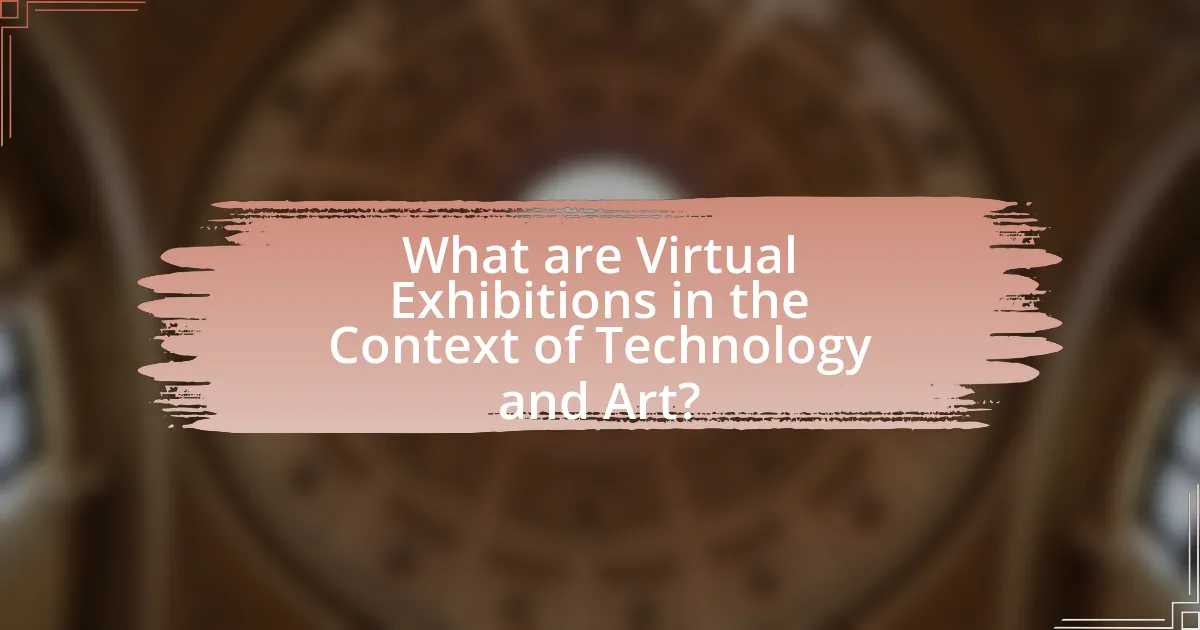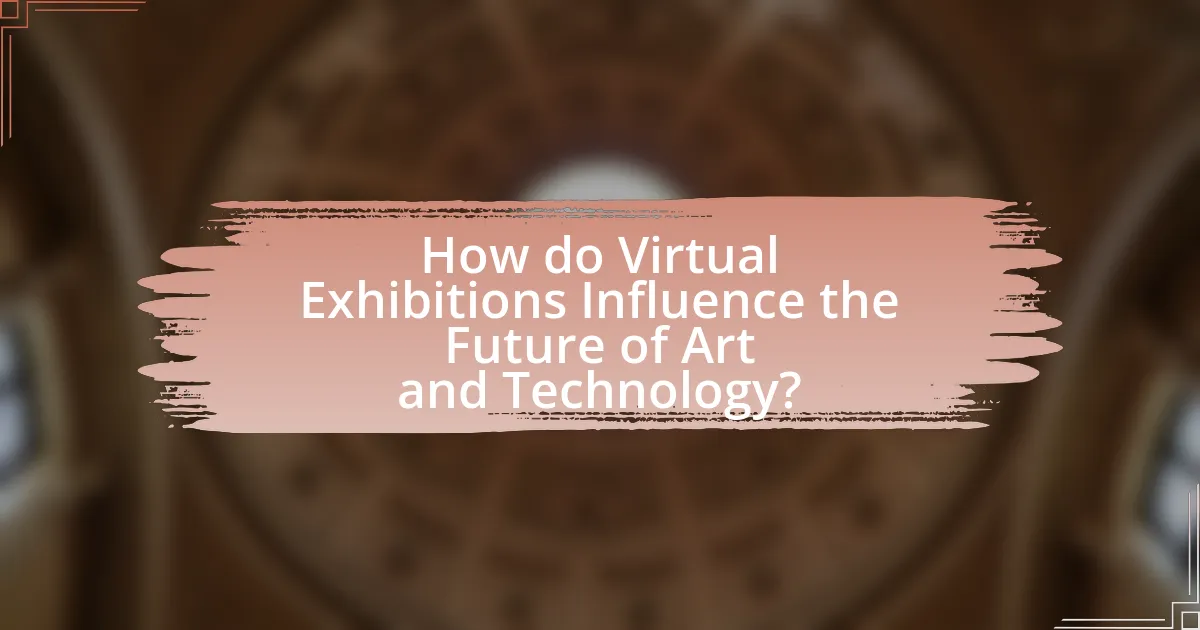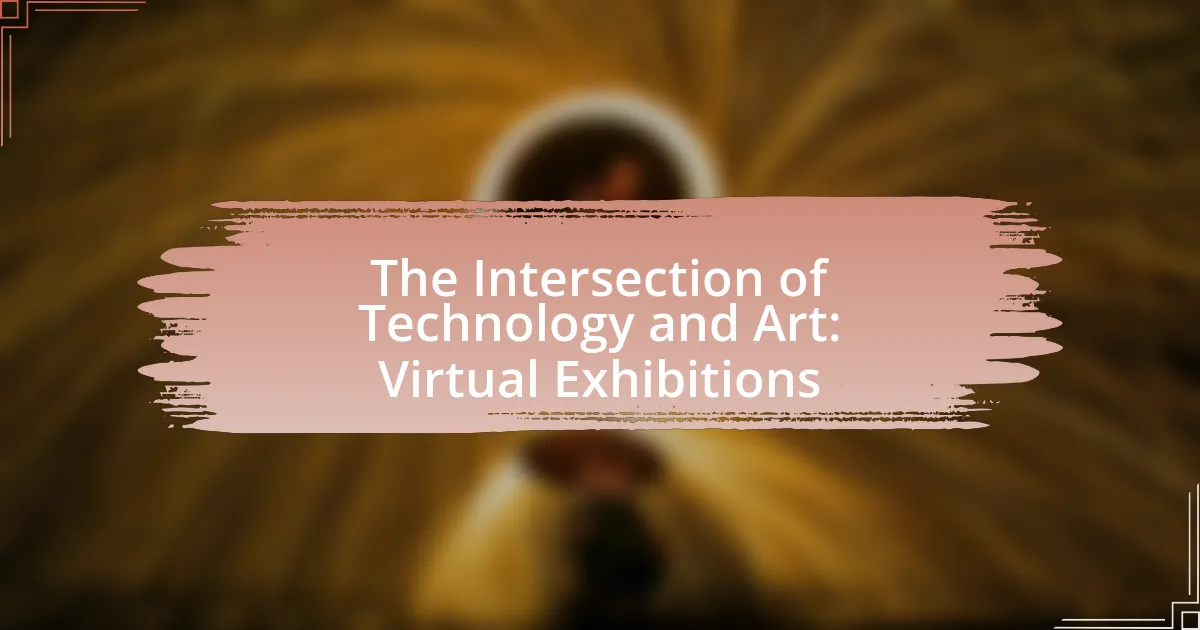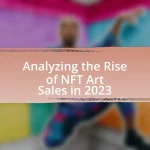Virtual exhibitions represent a significant evolution in the intersection of technology and art, utilizing digital platforms to showcase artworks through virtual reality, augmented reality, and online galleries. These exhibitions enhance accessibility by allowing global audiences to engage with art without geographical constraints, a shift that has gained momentum, particularly during the COVID-19 pandemic. Key technologies such as 3D modeling and immersive storytelling are employed to create interactive experiences that surpass traditional exhibition formats. The article explores the differences between virtual and physical exhibitions, the technologies involved, the impact of accessibility, and the challenges faced, while also highlighting emerging trends and best practices for artists and institutions in this evolving landscape.

What are Virtual Exhibitions in the Context of Technology and Art?
Virtual exhibitions in the context of technology and art are digital platforms that showcase artworks and artistic experiences through virtual reality, augmented reality, or online galleries. These exhibitions allow artists to reach a global audience without the constraints of physical space, enabling interactive and immersive experiences that traditional exhibitions cannot provide. For instance, the Museum of Modern Art (MoMA) has utilized virtual exhibitions to present collections and engage viewers through digital storytelling, demonstrating the effectiveness of technology in enhancing art accessibility and engagement.
How do Virtual Exhibitions differ from Traditional Art Exhibitions?
Virtual exhibitions differ from traditional art exhibitions primarily in their accessibility and presentation format. Virtual exhibitions allow viewers to access art from anywhere in the world via the internet, eliminating geographical barriers, while traditional exhibitions require physical attendance at a specific location. Additionally, virtual exhibitions often utilize interactive technologies, such as 3D modeling and augmented reality, to enhance the viewing experience, whereas traditional exhibitions rely on physical displays and in-person interactions. This shift towards digital platforms has been accelerated by the COVID-19 pandemic, which saw a 300% increase in virtual art events in 2020, highlighting the growing significance of technology in the art world.
What technologies are utilized in creating Virtual Exhibitions?
Virtual exhibitions utilize technologies such as 3D modeling, virtual reality (VR), augmented reality (AR), and web-based platforms. 3D modeling allows for the creation of realistic representations of artworks and spaces, enabling immersive experiences. Virtual reality provides fully immersive environments where users can explore exhibitions as if they were physically present. Augmented reality enhances the real-world environment by overlaying digital information, enriching the viewer’s experience. Web-based platforms facilitate accessibility, allowing users to engage with exhibitions from anywhere with an internet connection. These technologies collectively enhance the presentation and interaction with art in virtual settings.
How do Virtual Exhibitions enhance the viewer’s experience compared to physical exhibitions?
Virtual exhibitions enhance the viewer’s experience compared to physical exhibitions by providing greater accessibility and interactivity. Unlike physical exhibitions, which require travel and may have limited hours, virtual exhibitions can be accessed from anywhere at any time, allowing a broader audience to engage with the content. Additionally, virtual platforms often incorporate interactive elements such as 3D models, videos, and live chats with artists, which can create a more immersive experience. Research indicates that 70% of users prefer the convenience of virtual exhibitions over traditional formats, highlighting the shift in viewer preferences towards digital engagement.
Why are Virtual Exhibitions becoming increasingly popular?
Virtual exhibitions are becoming increasingly popular due to their accessibility and ability to reach a global audience. Unlike traditional exhibitions, which are limited by physical space and location, virtual exhibitions allow participants to engage from anywhere in the world, significantly expanding the potential viewer base. According to a report by the International Council of Museums, virtual exhibitions saw a 300% increase in participation during the COVID-19 pandemic, highlighting their growing relevance. Additionally, the integration of interactive technologies enhances user experience, making art more engaging and immersive. This combination of accessibility and innovative technology is driving the rise of virtual exhibitions in the art world.
What role does accessibility play in the rise of Virtual Exhibitions?
Accessibility is a crucial factor in the rise of virtual exhibitions, as it allows a broader audience to engage with art and cultural content regardless of physical limitations or geographical barriers. By providing online access, virtual exhibitions enable individuals with disabilities, those living in remote areas, and people unable to travel to participate in cultural experiences that were previously inaccessible. For instance, a study by the National Endowment for the Arts found that online platforms can increase audience reach by up to 50%, demonstrating the significant impact of accessibility on audience engagement. This shift not only enhances inclusivity but also fosters a diverse community of art enthusiasts, ultimately driving the growth of virtual exhibitions.
How has the COVID-19 pandemic influenced the adoption of Virtual Exhibitions?
The COVID-19 pandemic significantly accelerated the adoption of virtual exhibitions as organizations sought alternatives to in-person events. With physical venues closed and social distancing measures in place, many art institutions and businesses transitioned to online platforms to maintain engagement with audiences. According to a report by the International Council of Museums, 85% of museums worldwide closed during the pandemic, prompting a rapid shift to digital formats. This shift not only allowed for continued access to art and culture but also expanded audience reach, as virtual exhibitions became accessible to a global audience, breaking geographical barriers.

What are the Key Features of Successful Virtual Exhibitions?
Successful virtual exhibitions feature interactive elements, high-quality visuals, and user-friendly navigation. Interactive elements, such as live chats and Q&A sessions, engage attendees and foster real-time communication, enhancing the overall experience. High-quality visuals, including 3D models and immersive environments, create a captivating atmosphere that mimics physical exhibitions, making the content more appealing. User-friendly navigation ensures that visitors can easily explore the exhibition, find information, and access different sections without frustration. These features collectively contribute to a memorable and effective virtual exhibition experience.
How do artists and curators design engaging Virtual Exhibitions?
Artists and curators design engaging virtual exhibitions by utilizing interactive technologies, immersive storytelling, and user-centered design principles. They incorporate multimedia elements such as videos, audio, and 3D models to create a dynamic experience that captivates viewers. For instance, the use of virtual reality (VR) allows audiences to explore artworks in a simulated environment, enhancing emotional engagement. Additionally, curators often employ data analytics to understand audience preferences and tailor the exhibition experience accordingly, ensuring that the content resonates with viewers. This approach is supported by studies indicating that interactive elements significantly increase visitor engagement and retention in virtual settings.
What elements contribute to an immersive experience in Virtual Exhibitions?
An immersive experience in virtual exhibitions is primarily contributed by interactive elements, high-quality visuals, and engaging audio. Interactive elements, such as touchpoints and navigation tools, allow users to explore content actively, enhancing engagement. High-quality visuals, including 3D models and detailed imagery, create a realistic environment that captivates viewers. Engaging audio, such as ambient sounds and narrative voiceovers, further enriches the experience by providing context and emotional depth. Together, these elements create a cohesive and compelling virtual environment that mirrors physical exhibitions, as evidenced by studies showing increased user satisfaction and retention in immersive digital spaces.
How can interactivity be incorporated into Virtual Exhibitions?
Interactivity can be incorporated into virtual exhibitions through features such as live chat, interactive 3D models, and gamification elements. Live chat allows visitors to engage with curators or artists in real-time, enhancing the experience by providing immediate feedback and information. Interactive 3D models enable users to explore artworks from various angles, fostering a deeper understanding of the pieces. Gamification elements, such as quizzes or scavenger hunts, can encourage visitor participation and make the exhibition more engaging. These methods have been shown to increase visitor retention and satisfaction, as evidenced by studies indicating that interactive experiences lead to higher levels of engagement in digital environments.
What challenges do Virtual Exhibitions face?
Virtual exhibitions face several challenges, including technological limitations, user engagement issues, and accessibility concerns. Technological limitations can hinder the quality of the virtual experience, as inadequate bandwidth or outdated software may lead to lagging or crashing platforms. User engagement issues arise from the difficulty in replicating the immersive experience of physical exhibitions, resulting in lower visitor retention rates; studies show that virtual events often see a 30-50% drop-off in attendance compared to in-person events. Accessibility concerns also play a significant role, as not all users have equal access to the necessary technology or internet connectivity, which can exclude certain demographics from participating.
How do technical issues impact the effectiveness of Virtual Exhibitions?
Technical issues significantly diminish the effectiveness of virtual exhibitions by disrupting user experience and engagement. When participants encounter problems such as slow loading times, software glitches, or connectivity issues, their ability to interact with the exhibition content is compromised. Research indicates that 47% of users expect a website to load in two seconds or less, and a delay of just one second can lead to a 7% reduction in conversions (source: Akamai Technologies). This statistic underscores how technical difficulties can lead to frustration, decreased attendance, and ultimately lower satisfaction with the exhibition. Furthermore, if critical features like video streaming or interactive elements fail, the intended immersive experience is lost, resulting in a less impactful presentation of the art and technology intersection.
What are the limitations of Virtual Exhibitions in conveying artistic intent?
Virtual exhibitions have significant limitations in conveying artistic intent, primarily due to the lack of physical presence and sensory engagement. The absence of tactile interaction with artworks diminishes the viewer’s ability to fully appreciate texture, scale, and spatial relationships, which are crucial for understanding an artist’s message. Additionally, virtual platforms often rely on digital representations that may not accurately capture the nuances of color and detail found in physical pieces, leading to potential misinterpretations of the artist’s vision. Research indicates that immersive experiences, such as those provided by physical exhibitions, foster deeper emotional connections and understanding, which virtual formats struggle to replicate.

How do Virtual Exhibitions Influence the Future of Art and Technology?
Virtual exhibitions significantly influence the future of art and technology by democratizing access to art and enhancing viewer engagement through immersive experiences. These platforms allow artists to showcase their work globally without geographical limitations, thus reaching a broader audience. For instance, the virtual exhibition “The Night Cafe” uses VR technology to recreate Vincent van Gogh’s famous painting, allowing users to explore the space interactively, which exemplifies how technology can transform traditional art experiences. Additionally, a report by Art Basel and UBS indicates that online art sales reached $12.4 billion in 2021, highlighting the growing importance of digital platforms in the art market. This shift not only fosters innovation in artistic expression but also encourages the integration of advanced technologies, such as augmented reality and artificial intelligence, into the creative process.
What trends are emerging in the realm of Virtual Exhibitions?
Emerging trends in virtual exhibitions include increased interactivity, enhanced user experience through immersive technologies, and the integration of artificial intelligence for personalized content delivery. Interactivity is becoming a focal point, with platforms allowing users to engage with exhibits through live chats, Q&A sessions, and interactive displays. Immersive technologies, such as virtual reality (VR) and augmented reality (AR), are enhancing the viewing experience, enabling users to explore art in a three-dimensional space. Additionally, AI is being utilized to tailor experiences based on user preferences, making exhibitions more relevant and engaging. These trends reflect a shift towards creating more dynamic and personalized virtual environments, as evidenced by the rise in platforms like Artland and Kunstmatrix, which have reported increased user engagement and satisfaction.
How are advancements in technology shaping the future of Virtual Exhibitions?
Advancements in technology are significantly shaping the future of virtual exhibitions by enhancing interactivity, accessibility, and immersive experiences. Technologies such as virtual reality (VR) and augmented reality (AR) allow users to engage with art and exhibits in a more dynamic way, creating a sense of presence that traditional exhibitions cannot offer. For instance, a study by the International Council of Museums in 2021 highlighted that 70% of museums reported increased visitor engagement through the use of VR and AR technologies. Additionally, advancements in streaming and online platforms have made exhibitions accessible to a global audience, breaking geographical barriers and allowing for wider participation. This shift not only democratizes access to art but also enables artists and curators to reach diverse audiences, thereby transforming the landscape of art exhibitions.
What potential does Virtual Reality hold for the evolution of art exhibitions?
Virtual Reality (VR) holds significant potential for the evolution of art exhibitions by enabling immersive experiences that engage audiences in unprecedented ways. VR allows viewers to interact with art in a three-dimensional space, breaking the traditional boundaries of physical galleries. For instance, the VR exhibition “The Night Cafe,” inspired by Vincent van Gogh, allows users to explore a virtual recreation of the artist’s famous painting, demonstrating how VR can transform static art into dynamic experiences. Additionally, studies indicate that VR can enhance emotional connections to art, as users can experience artworks from multiple perspectives and contexts, fostering deeper appreciation and understanding. This innovative approach not only attracts a broader audience but also democratizes access to art, allowing individuals from various locations to participate in exhibitions that may otherwise be geographically restricted.
What best practices should artists and institutions follow when creating Virtual Exhibitions?
Artists and institutions should prioritize user experience, accessibility, and interactivity when creating virtual exhibitions. A seamless user interface enhances engagement, while accessibility features ensure that diverse audiences can participate. Incorporating interactive elements, such as virtual tours or live Q&A sessions, fosters deeper connections with the artwork. Research indicates that 70% of users prefer interactive content over static content, highlighting the importance of engagement strategies. Additionally, utilizing high-quality visuals and sound can significantly enhance the immersive experience, as studies show that visual and auditory elements can increase retention rates by up to 60%.
How can feedback from viewers improve future Virtual Exhibitions?
Feedback from viewers can significantly enhance future Virtual Exhibitions by providing insights into user preferences and experiences. This feedback allows organizers to identify strengths and weaknesses in the exhibition’s design, content, and interactivity. For instance, a study by the International Council of Museums found that 70% of virtual exhibition attendees preferred interactive elements, indicating that incorporating more engaging features could improve viewer satisfaction. By analyzing viewer comments and ratings, curators can make data-driven decisions to refine the exhibition layout, enhance accessibility, and tailor content to better meet audience expectations.
What strategies can enhance audience engagement in Virtual Exhibitions?
Interactive features such as live Q&A sessions, polls, and chat functionalities significantly enhance audience engagement in virtual exhibitions. These elements allow attendees to actively participate, fostering a sense of community and connection. For instance, a study by the Virtual Events Institute found that events incorporating interactive elements saw a 70% increase in attendee satisfaction compared to traditional formats. Additionally, utilizing immersive technologies like virtual reality can create a more engaging experience, as evidenced by the success of the “The Night Cafe” VR exhibition, which attracted over 100,000 visitors in its first month.


